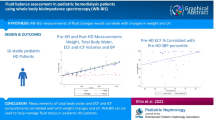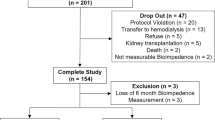Abstract
Background
To calculate Kt/V, volume (V) is usually obtained by Watson formula, but bioimpedance spectroscopy (BIS) is a simple and applicable technique to determinate V, along with other hydration and nutrition parameters, in peritoneal dialysis (PD) patients. Dialysis efficacy can also be measured with Kt, but no experience exists in PD, so there is no reference/target value for Kt that must be achieved in these patients to be considered adequately dialyzed. We evaluated the efficacy of PD with Kt/V using Watson formula and BIS for V calculation, assessed hydration status in a PD unit by data obtained by BIS, and attempted to find a reference Kt from the Kt/V previously obtained by BIS.
Methods
In this observational prospective study of 78 PD patients, we measured V using BIS (V bis) and Watson formula (V w) and calculated weekly Kt/V using both volumes (Kt/V bis/V bis and Kt/V w). With the BIS technique, we obtained and subsequently analyzed other hydration status parameters. We achieved a reference Kt, extrapolating the value desired (weekly Kt/V 1.7) to the target Kt using the simple linear regression statistical technique, basing it on the results of the previously calculated Pearson’s linear correlation coefficient.
Results
Volume was 1.8 l higher by Watson formula than with BIS (p < 0.001). Weekly Kt/V bis was 2.33 ± 0.68, and mean weekly Kt/V w was 2.20 ± 0.63 (p < 0.0001); 60.25 % of patients presented overhydration according to the BIS study (OH >1.1 l). The target value of Kt for the reference weekly Kt/V bis (1.7) was 64.87 l.
Conclusions
BIS is a simple, applicable technique for calculating V in dialysis that can be especially useful in PD patients compared with the anthropometric formulas, by the abnormally distributed body water in these patients. Other parameters obtained by BIS will serve to assess both the distribution of body volume and nutritional status in the clinical setting. The target Kt value obtained from Kt/V bis allowed us to measure the efficacy of PD in a practical way, omitting V measurement.







Similar content being viewed by others
References
Arrieta J, Bajo MA, Caravaca F, Coronel F, García-Pérez H, González-Parra E, et al. Guidelines of the Spanish Society of Nephrology. Clinical practice guidelines for peritoneal. Nefrología. 2006;26(4):1–184.
Watson PE, Watson ID, Batt RD. Total body water volumes for adult males and females estimated from simple anthropometric measurements. Am J Clin Nutr. 1980;33:27–39.
Hume R, Weyers E. Relationship between total body water and surface area in normal and obese subjects. J Clin Pathol. 1971;24(3):234–8.
NKF-DOQI. Clinical practice guidelines for peritoneal dialysis adequacy. Am J Kidney Dis. 1997;30 Suppl 2:S67–136.
NKF-DOQI Updated 2000, Guideline 15. Clinical practice guidelines for peritoneal dialysis adequacy. Am J Kidney Dis. 2001;27 Suppl. 1:S128–31.
Kushner RF. Bioelectrical impedance analysis: a review of principles and applications. J Am Coll Nutr. 1992;11:199–209.
Teruel JL, Fernández Lucas M, Marcén R, et al. Estimate of the dialysis dose using ionic dialysance. Nefrología. 2001;21:78–83.
Maduell F, Vera M, Serra N, Collado S, Carrera M, Fernández A, et al. Kt as control and follow-up of the dose at a hemodialysis unit. Nefrologia. 2008;28(1):43–7.
Arkouche W, Fouque D, Pachiaudi C, Normand S, Laville M, Delawari E, Riou JP, Traeger J, Laville M. Total body water and body composition in chronic peritoneal dialysis patients. J Am Soc Nephrol. 1997;8(12):1906–14.
Zhu F, Wystrychowski G, Kitzler T, Thijssen S, Kotanko P, Levin NW. Application of bioimpedance techniques to peritoneal dialysis. Contrib Nephrol. 2006;150:119–28.
Wieskotten S, Heinke S, Wabel P, Moissl U, Becker J. Bioimpedance-based identification of malnutrition using fuzzy logic. Physiol Meas. 2008;29:639–54.
Picolli A. Bioelectric impedance vector distribution in peritoneal dialysis patients with different hydration status. Kidney Int. 2004;65:1050–63.
Essig M, Escoubet B, de Zuttere D, Blanchet F, Arnoult F, Dupuis E, et al. Cardiovascular remodelling and extracellular fluid excess in early stages of chronic kidney disease. Nephrol Dial Transplant. 2008;23:1050–63.
Wang AY, Lam CW, Wang M, Chan IH, Goggins WB, Yu CM, et al. Prognostic value of cardiac troponin T is independent of inflammation, residual renal function, and cardiac hypertrophy in peritoneal dialysis patients. Clin Chem. 2008;53:882–9.
Demirci MS, Demirci C, Ozdogan O, Kircelli F, Akcikek F, Brasci A, et al. Relations between malnutrition–inflammation–atherosclerosis and volume status. The usefulness of bioimpedance analysis in peritoneal dialysis. Nephrol Dial Transplant. 2011;26(5):1708–16.
Cheng LT, Tang W, Wang T. Strong association between volume status and nutritional status in peritoneal dialysis patients. Am J Kidney Dis. 2005;45:891–902.
Koh KH, Wong HS, Go KW, Morad Z. Normalized bioimpedance indices are better predictors of outcome in peritoneal dialysis patients. Perit Dial Int. 2010;31(5):574–82.
Jaffrin MY, Morel H. Body fluid volumes measurement by impedance: a review of bioimpedance spectroscopy (BIS) and bioimpedance analysis (BIA) methods. Med Eng Phys. 2008;30(10):1257–69.
Woodrow G, Oldroyd B, Wright A, Coward WA, Truscott JG. The effect of normalization of ECW volume as a marker of hydration in peritoneal dialysis patients and control. Perit Dial Int. 2005;25(3):S49–51.
Cooper BA, Aslani A, Ryan M, Zhu F, Ibels LS, Allen BJ, Pollock CA. Comparing different methods of assessing body composition in end-stage renal failure. Kidney Int. 2000;58:408–16.
Moissl UM, Wabel P, Chamney PW, Bosaeus I, Levin NW, Bosy-Westphal A, Korth O, Müller MJ, Ellegård L, Malmros V, Kaitwatcharachai C, Kuhlmann MK, Zhu F, Fuller NJ. Body fluid volume determination via body composition spectroscopy in health and disease. Physiol Meas. 2006;27(9):921–33.
Passauer J, Petrov H, Schleser A, Leicht J, Pucalka K. Evaluation of clinical dry weight assessment in haemodialysis patients using bioimpedance spectroscopy: a cross-sectional study. Nephrol Dial Transplant. 2010;25:545–51.
Machek P, Jirka T, Moissl U, Chamney P, Wabel P. Guided optimization of fluid status in haemodialysis patients. Nephrol Dial Transplant. 2010;25(2):538–44.
Van Biesen W, Williams JD, Covic AC, Fan S, Claes K, Lichodziejewska-Niemierko M, et al. Fluid status in peritoneal dialysis patients: the European body composition monitoring (Euro BCM) study cohort. PLoS One. 2011;6(2):e17148.
Woodrow G, Devine Y, Cullen M, Lindley E. Application of bioelectrical impedance to clinical assessment of body composition in peritoneal dialysis. Perit Dial Int. 2007;27(5):496–502.
Crepaldi C, Soni S, Chionh CY, Wabel P, Cruz DN, Ronco C. Application of body composition monitoring to peritoneal dialysis patients. Contrib Nephrol. 2009;163:1–9.
Basile C, Vernaglione L, Bellizzi V, Lomonte C, Rubino A, D’Ambrosio N, Di Iorio B. Total body water in health and disease: have anthropometric equations any meaning? Nephrol Dial Transplant. 2008;23:1997–2002.
Wabel P, Chamney P, Moissl U, Jirka T. Importance of whole-body bioimpedance spectroscopy for the management of fluid balance. Blood Purif. 2009;27:75–80.
Peticlerc T, Goux N, Reynier AL, Bene B. A model for non invasive estimation of in vivo dialyzer performances and patient’s conductivity during hemodialysis. Int J Artif Organs. 1993;16:585–91.
Steil H, Kaufman AM, Morris AT, Levin NW, Polaschegg HD. In vivo verification of an automatic non invasive system for real time Kt evaluation. ASAIO. 1993;39:348–52.
Peticlerc T, Bene B, Jacobs C, Jaudon MC, Goux N. Non-invasive monitoring of effective dialysis dose delivered to the haemodialysis patient. Nephrol Dial Transplant. 1995;10:212–6.
Lowrie EG, Chertow GM, Lew NL, Lazarus JM, Owen WF. The urea (clearance × dialysis time) product (Kt) as an outcome-based measure of hemodialysis dose. Kidney Int. 1999;56:729–37.
Lowrie EG, Li Z, Ofsthun NJ, Lazarus JM. The online measurement of hemodialysis dose (Kt): clinical outcome as a function of body surface area. Kidney Int. 2005;68:1344–54.
Acknowledgments
This study was in part supported by BIOTYC Foundation, Grant 01/2011.
Conflict of interest
None.
Author information
Authors and Affiliations
Corresponding author
About this article
Cite this article
Martínez Fernández, G., Ortega Cerrato, A., Masiá Mondéjar, J. et al. Efficacy of dialysis in peritoneal dialysis: utility of bioimpedance to calculate Kt/V and the search for a target Kt . Clin Exp Nephrol 17, 261–267 (2013). https://doi.org/10.1007/s10157-012-0671-x
Received:
Accepted:
Published:
Issue Date:
DOI: https://doi.org/10.1007/s10157-012-0671-x




